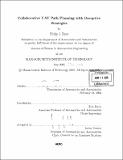| dc.contributor.advisor | Eric Feron. | en_US |
| dc.contributor.author | Root, Philip J | en_US |
| dc.contributor.other | Massachusetts Institute of Technology. Dept. of Aeronautics and Astronautics. | en_US |
| dc.date.accessioned | 2006-03-29T18:44:07Z | |
| dc.date.available | 2006-03-29T18:44:07Z | |
| dc.date.copyright | 2005 | en_US |
| dc.date.issued | 2005 | en_US |
| dc.identifier.uri | http://hdl.handle.net/1721.1/32432 | |
| dc.description | Thesis (S.M.)--Massachusetts Institute of Technology, Dept. of Aeronautics and Astronautics, 2005. | en_US |
| dc.description | Includes bibliographical references (p. 87-89). | en_US |
| dc.description.abstract | In this thesis, we propose a strategy for a team of Unmanned Aerial Vehicles (UAVs) to perform reconnaissance of an intended route while operating within aural and visual detection range of threat forces. The advent of Small UAVSs (SUAVs) has fundamentally changed the interaction between the observer and the observed. SUAVs fly at much lower altitudes than their predecessors, and the threat can detect the reconnaissance and react to it. This dynamic between the reconnaissance vehicles and the threat observers requires that we view this scenario within a game theoretic framework. We begin by proposing two discrete optimization techniques, a recursive algorithm and a Mixed Integer Linear Programming (MILP) model, that seek a unique optimal trajectory for a team of SUAVs or agents for a given environment. We then develop a set of heuristics governing the agents' optimal strategy or policy within the formalized game, and we use these heuristics to produce a randomized algorithm that outputs a set of waypoints for each vehicle. Finally, we apply this final algorithm to a team of autonomous rotorcraft to demonstrate that our approach operates flawlessly in real-time environments. | en_US |
| dc.description.statementofresponsibility | by Philip J. Root. | en_US |
| dc.format.extent | 89 p. | en_US |
| dc.format.extent | 4972730 bytes | |
| dc.format.extent | 4977003 bytes | |
| dc.format.mimetype | application/pdf | |
| dc.format.mimetype | application/pdf | |
| dc.language.iso | eng | en_US |
| dc.publisher | Massachusetts Institute of Technology | en_US |
| dc.rights | M.I.T. theses are protected by copyright. They may be viewed from this source for any purpose, but reproduction or distribution in any format is prohibited without written permission. See provided URL for inquiries about permission. | en_US |
| dc.rights.uri | http://dspace.mit.edu/handle/1721.1/7582 | |
| dc.subject | Aeronautics and Astronautics. | en_US |
| dc.title | Collaborative UAV path planning with deceptive strategies | en_US |
| dc.title.alternative | Collaborative Unmanned Aerial Vehicles path planning with deceptive strategies | en_US |
| dc.type | Thesis | en_US |
| dc.description.degree | S.M. | en_US |
| dc.contributor.department | Massachusetts Institute of Technology. Department of Aeronautics and Astronautics | |
| dc.identifier.oclc | 61718533 | en_US |
